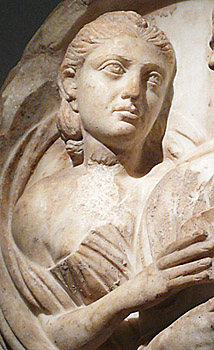
Funerary roundel, marble 250-270 CE
Monica was born in 331 CE into a Christian family in the Numidian town of Thagaste (modern Souk Ahras in Algeria), a Roman municipium inhabited by Romanized native Berbers. The deeply personal story of her life as a young woman living in the Roman province of North Africa at a time of transition in the Roman Empire from a pagan to a christian culture is preserved in her son's autobiography. She was married at puberty to a local town official, probably much older than she, by the name of Patricius, about whom Augustine has little to say. She bore Patricius three children who survived into adulthood: Augustine (354-430 CE; Bishop of Hippo from 396; canonized 1303), Navigius and Perpetua. Not being a Christian, her husband permitted none of his children to be baptized, although he tolerated Monica's religious devotion. On his deathbed he agreed to be baptized, leaving her a widow at age 40 in 371 CE. From that time to the end of her life she made it her mission to have her elder son Augustine, who studied rhetoric in Carthage, converted to the faith. To that end she followed him to Rome and Milan, patiently praying for and guiding him. Augustine gives a vivid picture of this persevering, reasonable, dignified matrona from her childhood, which was not without fault, to her peaceful death. In her marriage she was supported by her faith, her loyalty to her husband and her dutifulness; during her son's dissolute early life, she was comforted and strengthened by dream visions of his salvation. Once she had succeeded in persuading Augustine to give up his sinful life and be baptized into the faith, she accompanied him from Milan to Rome, intending to return to North Africa to be buried beside her husband. However, falling ill with a fever in the harbor town of Ostia, she died and was buried there in 387 CE, where a monument for her was placed (see its history), carved with an epitaph written by Anicius Anchenius Bassus (consul 431 CE). In succeeding centuries her bones were moved to Rome (tomb in the Basilica of St. Augustine) and she was widely venerated as Saint Monica for her virtues as wife and mother. In the passage below Augustine bears passionate witness to the informal but real power of the materfamilias within her family. In it he describes how Monica studied her husband and learned how to successfully manage his quick anger and frustration. In this way she maintained the concordia (representation of the goddess) of her household and preserved herself from the spousal abuse that the matronae of the town bemoaned. Consulted by them, she attempted to pass on her practices, advising them to see the marriage contract, which transferred them from the potestas of fathers to husbands, as tantamount to slave bondage which required submission of wives to their husbands. While domestic abuse is only sporadically reported, there is evidence of it throughout the Roman Empire in stories of elite women (Poppaea, Regilla) as well as those of the lower classes (Fortunata, tomb inscriptions). For further information on Monica see Clark (in Murnaghan 1999), G. Clark (2015), and Cooper (2023) in the Bibliography.
Ubi plenis annis nubilis facta est, tradita viro servivit veluti domino et sategit eum lucrari tibi, loquens te illi moribus suis, quibus eam pulchram faciebas et reverenter amabilem atque mirabilem viro.
Ita autem toleravit cubilis iniurias ut nullam de hac re cum marito haberet umquam simultatem. Expectabat enim misericordiam tuam super eum, ut in te credens castificaretur. Erat vero ille praeterea sicut benivolentia praecipuus, ita ira fervidus. Sed noverat haec non resistere irato viro, non tantum facto sed ne verbo quidem. Iam vero refractum et quietum cum opportunum viderat, rationem facti sui reddebat, si forte ille inconsideratius commotus fuerat.
Denique cum matronae multae, quarum viri mansuetiores erant, plagarum vestigia etiam dehonestata facie gererent, inter amica conloquia illae arguebant maritorum vitam, haec earum linguam, veluti per iocum graviter admonens, ex quo illas tabulas quae matrimoniales vocantur recitari audissent, tamquam instrumenta quibus ancillae factae essent deputare debuisse; proinde memores condicionis superbire adversus dominos non oportere.
Cumque mirarentur illae, scientes quam ferocem coniugem sustineret, numquam fuisse auditum aut aliquo indicio claruisse quod Patricius ceciderit uxorem aut quod a se invicem vel unum diem domestica lite dissenserint, et causam familiariter quaererent, docebat illa institutum suum, quod supra memoravi.
Quae observabant, expertae gratulabantur; quae non observabant, subiectae vexabantur.
Click on the underlined words for translation aids and commentary, which will appear in a small window.